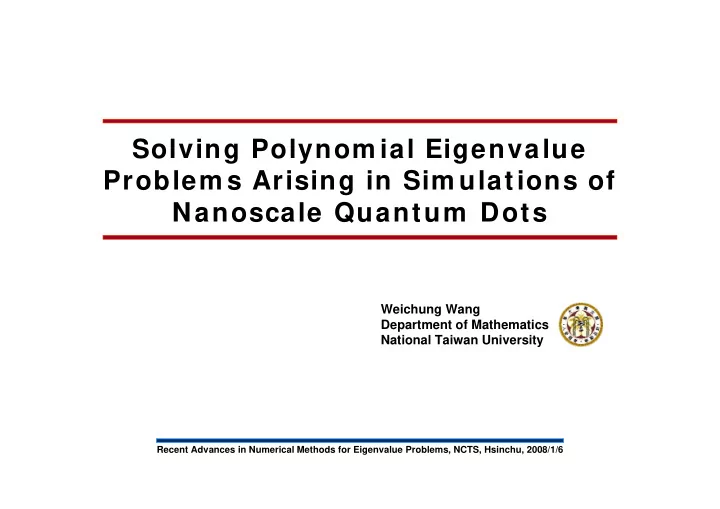

Energy states (eigenvalues) λ λ j-Ord Ite. Time j-Ord Ite. Time 1-1 0.0874 1922 2445 4-1 0.1709 1246 1598 1-2 0.1503 479 661 4-2 0.2812 613 851 5-1 0.2054 435 583 1-3 0.2460 815 1231 5-2 0.3245 566 821 1-4 0.3305 1273 2080 2-1 0.1102 631 799 6-1 0.2412 913 1213 7-1 0.2777 533 695 2-2 0.1932 524 723 8-1 0.3141 632 814 2-3 0.2972 666 1007 9-1 0.3496 1069 1362 2-4 0.3385 851 1394 3-1 0.1387 1727 2204 3-2 0.2371 525 735 3-3 0.3454 2091 3191 3-4 0.3486 759 1252 51
52 Non-uniform mesh Structure schema of a QD array
Ground state energies • Ground state energies for • various spacer layer distances d 0 • number of quantum dots. 53
54 Bifurcation for two quantum dots.
55 When the bifurcation happens
Uniform mesh with 2nd order convergence rate Non-uniform mesh Uniform mesh 56
57 All bounded state energy levels
58 Dynamics of the wave functions
Effect of pile-up dots • More interactions are found in higher energy levels 59
Effect of pile-up dots (cont.) • More interactions are found in higher energy levels 60
Effect of gap distance • Smaller gap distance leads to stronger interactions vs vs 61
Effect of different size QDs • Larger dot results in more interactions 62
Effect of different size QDs • Larger dots result in more interactions 63
64 Anti-crossing and crossing
65 Bifurcation for two same size quantum dots.
A close look of the crossing and anti-crossing Fine mesh (2560x4320=11,059,200) with Δ r = Δ z = 0.0063 nm 66
Wave functions in crossing and anti-crossing areas • Crossing • Anti-Crossing 2nd E.V. 3rd E.V. 2nd E.V. 3rd E.V. Top figures: R 2 = 3.1981 nm ; Bottom figures: R 2 = 3.2044 nm ( Δ r = 0.0063 nm ) 67
Pyramid quantum dot
• Discretization • Eigensolver • Physics
A finite volume discretization • 3D scheme: denote surface and volume average over the control element • uniform mesh due to the geometric structure • automatically builds in the interface condition 70
The 3D scheme • Exterior/interior points: l ocal truncation error O(h^2) • Interface points: l ocal truncation error O(h) • Surfaces (N, W, S, E, B) • Edges (NW, WS, SE, EN, NB, WB, SB, EB) • Corners (NW, WS, SE, EN, Tip) 71
72 2nd order convergence rate
• Discretization • Eigensolver • Physics
Efficiency on a ordinary PC • Matrix size: 1 , 532 , 255 • Pentium 4 (1.8GHz) and 800MB of main memory 74
Efficiency on a decent workstation • Matrix size: 32,401,863 (352 × 352 × 264) • Intel Itanium II (1.0GHz) and 12 GB of main memory. (5000 sec ~ 1 hr 20 min; 8600 sec ~ 2 hr 20 min) 75
Sparsity patterns ( L,M,N ) = (8, 8, 6) 76
Matrices properties • A ü A Á , A ª , A £ A ¢ , A ° ▲ (partial) ▲ (partial) ● yes (Diag. mtx.) Symmetry ● (yes) ▲ (partial) ● yes (Diag. mtx.) Diagonal Dominance ▲ : except the row entries involving interface grids • Asymptotic structure B is a low rank matrix. 77
• Discretization • Eigensolver • Physics
79 Wave fts. assoc. w/ λ Á and λ ª
Computational results in energy states Changes of energy states in terms of truncated QD heights (Dimension: 63 x 63 x N) 80
81 Computational results in wave functions
Irregular shape quantum dot
• Discretization • Eigensolver • Physics
84 Schema
Scheme 1: Curvilinear coordinate • Matrix A L : Sym. Pos. Def.; 9 nonzeros each row • Matrix B L : diagonal matrix 85
Scheme 2: The skewed coordinate • Matrix A S : Sym. Pos. Def.; 9 nonzeros each row • Matrix B S : diagonal matrix 86
Scheme 3: Mixed coordinate • Symmetry preserving average • Not clear how ω affects the convergence of the eigenvalue solver analytically • Numerical investigation provides some clues 87
88 Effect of the symmetry average parameter
89 Convergence rate (cont.)
90 Summary of the proposed schemes
• Discretization • Eigensolver • Physics
Jacobi-Davidson method for polynomial eigenvalue prob. • A Jacobi-Davidson method with locking (and restarging) 92
Solving the correction equation • Sleijpen and van der Vorst (SIMA96) 93
Computing the smallest positive eigenvalue − = + σ + σ 1 ( ) ( ) M D L D D U • SSOR: 94
95 Computing the successive eigenvalues
Performance of SSOR preconditioner • Dimension: 1,935,090 • HP workstation with 1.3GHz Intel Itanium II CPU with 24 GB memory • Average timing for computing all target eigenpairs 96
• Discretization • Eigensolver • Physics
98 Eigenvalue spectrum
Eigenvectors (wave functions) • Ground state ( λ 1 =0.3869 eV), 1st excited ( λ 2 =0.6670 eV) , and 2nd excited ( λ 3 =0.7410 eV) state energy • The first three eigenvectors associated with the first three smallest positive eigenvalues. 99
Conclusion
Recommend
More recommend